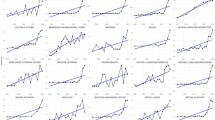Abstract
This chapter addresses the question of whether it is enough to extract from data the knowledge needed to implement socially believable conversational agents. Contrary to the popular views, the answer is negative. In this respect, the chapter points to some shortcomings of fully data-driven approaches to dialogue management, including the lack of external criteria for the selection of dialogue corpora, and the misconception of dialogue structure and dialogue context. To point to these shortcomings is not to undervalue data-driven approaches, but to emphasize the message that big data provide only a partial account of human-machine dialogue, and thus must not remain wedded to small linguistic theory, as it is currently the case.
Access this chapter
Tax calculation will be finalised at checkout
Purchases are for personal use only
Similar content being viewed by others
Notes
- 1.
A typical architecture often found in literature contains two additional components for speech recognition and synthesis. They are omitted in Fig. 13.1, since they are not in the focus of this chapter.
- 2.
The notion of a socially believable conversational agent is discussed in [6] in more detail. Here I rely on the reader’s intuitive understanding of this notion.
- 3.
It should be kept in mind that the order of n-gram models in practical applications is typically not very high, due to the requirement of efficiency.
- 4.
I consider here anaphoric references simply because they can be resolved within linguistic context. Exophoric references point outward from the dialogue, e.g., they may be recoverable from a spatial context. They are not included in the example in order to show that even when an element that is pointed to anaphorically (i.e., an antecedent) is explicitly stated in the dialogue, the established relation is not necessarily local.
- 5.
This is actually the relation of satisfaction-precedence (cf. [11]), but the phrase “linear precedence” is used to emphasize the assumption that dialogue structure is sequential.
References
Alexandersson, J., Reithinger, N.: Learning dialogue structures from a corpus. In: Proceedings of EuroSpeech-97, Rhodes, pp. 2231–2235 (1997)
Bengio, Y., Ducharme, R., Vincent, P., Jauvin, C.: A neural probabilistic language model. J. Mach. Learn. Res. 3, 1137–1155 (2003)
Bilange, E.: An approach to oral dialogue modelling. In: Taylor, M.M., Néel, F., Bouwhuis, D.G. (eds.) The Structure of Multimodal Dialogue II, pp. 189–205. John Benjamins Publishing Company, Philadelphia/Amsterdam (2000)
Chomsky, N.: Language and the Cognitive Science Revolution(s) (2011). https://chomsky.info/20110408/. Cited 19 Feb 2018
Ghazvininejad, M., Brockett, C., Chang, M.-W., Dolan, B., Gao, J., Yih, W.-t., Galley, M.: A Knowledge-Grounded Neural Conversation Model, Association for the Advancement of Artificial Intelligence (2018)
Gnjatović, M., Borovac, B.: Toward conscious-like conversational agents. In: Toward Robotic Socially Believable Behaving Systems, Volume II—Modeling Social Signals. Esposito, A., Jain, L.C. (eds.), volume 106 of the series Intelligent Systems Reference Library, pp. 23–45. Springer (2016)
Gnjatović, M.: Therapist-centered design of a robot’s dialogue behavior. Cogn. Comput. 6(4), 775–788 (2014)
Gnjatović, M., Delić, V.: Cognitively-inspired representational approach to meaning in machine dialogue. Knowl.-Based Syst. 71, 25–33 (2014)
Gnjatović, M., Janev, M., Delić, V.: Focus tree: modeling attentional information in task-oriented human-machine interaction. Appl. Intell. 37(3), 305–320 (2012)
Grosz, B.: Smart enough to talk with us? Foundations and challenges for dialogue capable AI systems. Comput. Linguist. 44(1), 1–15 (2018)
Grosz, B., Sidner, C.: Attention, intentions, and the structure of discourse. Comput. Linguist. 12(3), 175–204 (1986)
Halliday, M.A.K., Matthiessen, C.M.I.M.: An Introduction to Functional Grammar, 3rd edn. Hodder Arnold (2004)
Jokinen, K., McTear, M.: Spoken Dialogue Systems. Synthesis Lectures on Human Language Technologies, vol. 2(1), pp. 1–151. Morgan Claypool (2009)
Jurafsky, D., Martin, J.H.: Speech and Language Processing: An Introduction to Natural Language Processing, Speech Recognition, and Computational Linguistics, 2nd edn. Prentice-Hall (2009)
Lovász, L.: Random walks on graphs: a survey, combinatorics, Paul Erdos is eighty. Bolyai Society Mathematical Studies, vol. 2, pp. 1–46 (1993)
Lowe, R., Pow, N., Serban, I., Pineau, J.: The Ubuntu dialogue corpus: a large dataset for research in unstructured multi-turn dialogue systems. In: Special Interest Group on Discourse and Dialogue, SIGDIAL (2015)
Li, J., Monroe, W., Shi, T., Ritter, A., Jurafsky, D.: Adversarial Learning for Neural Dialogue Generation. Empirical Methods in Natural Language Processing (EMNLP) (2017)
Mikolov, T., Karafiát, M., Burget, L., Černocký, J.H., Sanjeev Khudanpur, S.: Recurrent neural network based language model. In: Proceedings of INTERSPEECH, pp. 1045–1048 (2010)
Mikolov, T., Yih, W.-t., Zweig, G.: Linguistic regularities in continuous space word representations. In: Proceedings of NAACL-HLT 2013, Association for Computational Linguistics, pp. 746–751 (2013)
Miller, G.A.: The cognitive revolution: a historical perspective. Trends Cogn. Sci. 7(3), 141–144 (2003)
Rabiner, L.R., Schafer, R.W.: Digital Processing of Speech Signals. Prentice-Hall (1978)
Ritter, A., Cherry, C., Dolan, W.B.: Data-driven response generation in social media. In: Proceedings of EMNLP 2011, pp. 583–593 (2011)
Ritter, A., Cherry, C., Dolan W.B.: Unsupervised modeling of twitter conversations. In: Human Language Technologies: The 2010 Annual Conference of the North American Chapter of the Association for Computational Linguistics, HLT ’10, Morristown, NJ, USA, pp. 172–180 (2010)
Roulet, E.: On the structure of conversation as negotiation. In: Parret, H., Verschueren, J. (eds.) (On) Searle on Conversation, pp. 91–99. John Benjamins Publishing Company, Philadelphia/Amsterdam (1992)
Savić, S., Gnjatović, M., Mišković, D., Tasevski, J., Maček, N.: Cognitively-inspired symbolic framework for knowledge representation. In: Proceedings of the 8th IEEE International Conference on Cognitive Infocommunications (CogInfoCom), Debrecen, Hungary, pp. 315–320 (2017)
Schegloff, E.A.: Sequencing in conversational openings. Am. Anthropol. 70, 1075–1095 (1968)
Searle, J.: Conversation. In: Parret, H., Verschueren, J. (eds.) (On) Searle on Conversation, pp. 7–29. John Benjamins Publishing Company, Philadelphia/Amsterdam (1992)
Serban, I.V., Lowe, R., Charlin, L., Pineau, J.: A Survey of Available Corpora for Building Data-Driven Dialogue Systems. arXiv e-prints, arXiv:1512.05742 (2015)
Serban, I.V., Sordoni, A., Bengio, Y., Courville, A., Pineau, J: Building end-to-end dialogue systems using generative hierarchical neural network models. In: Proceedings of the Thirtieth AAAI Conference on Artificial Intelligence, AAAI’16, pp. 3776–3783 (2016)
Shang, L., Lu, Z., Li, H.: Neural responding machine for short-text conversation. In: Proceedings of the 53rd Annual Meeting of the Association for Computational Linguistics and the 7th International Joint Conference on Natural Language Processing, pp. 1577–1586. Beijing, China (2015)
Shoham, Y.: Why knowledge representation matters. Commun. ACM 59(1), 47–49 (2015)
Sinclair, J.: Corpus and text—basic principles. In: Wynne, M. (ed.) Developing Linguistic Corpora: A Guide to Good Practice, pp. 1–16. Oxbow Books, Oxford (2005)
Sordoni, A., Galley, M., Auli, M., Brockett, C., Ji, Y., Mitchell, M., Nie, J-Y., Gao, J., Dolan, B.: A neural network approach to context-sensitive generation of conversational responses. In: Proceedings of HLT-NAACL, pp. 196–205 (2015)
Stolcke, A., Ries, K., Coccaro, N., Shriberg, E., Bates, R., Jurafsky, D., Taylor, P., Martin, R., Van Ess-Dykema, C., Meteer, M.: Dialogue act modeling for automatic tagging and recognition of conversational speech. Comput. Linguist. 26(3), 339–373 (2000)
Tognini-Bonelli, E.: Corpus Linguistics at Work. John Benjamins, Amsterdam (2001)
Vinyals, O., Le, Q.V.: A neural conversational model. In: ICML Deep Learning Workshop, arXiv:1506.05869 [cs.CL] (2015)
Widdowson, H.G.: On the limitations of linguistics applied. Appl. Linguist. 21(1), 3–25 (2000)
Wilks, Y.: Is there progress on talking sensibly to machines? Science 318(5852), 927–928 (2007)
Wilks, Y.: IR and AI: traditions of representation and anti-representation in information processing. In: McDonald, S., Tait, J. (eds.) Advances in Information Retrieval. ECIR 2004. Lecture Notes in Computer Science, vol. 2997, pp. 12–26. Springer, Berlin, Heidelberg (2004)
Wilks, Y., Catizone, R., Turunen, M.: Dialogue Management. COMPANIONS Consortium: State of the Art Papers (2006) Public report. https://pdfs.semanticscholar.org/fea2/03cd009a66cc232ead6b808f1c9f67c86f3f.pdf. Cited 19 Feb 2018
Acknowledgements
The presented study was sponsored by the Ministry of Education, Science and Technological Development of the Republic of Serbia (research grants III44008 and TR32035), and by the intergovernmental network EUREKA (research grant E!9944). The responsibility for the content of this article lies with the author.
Author information
Authors and Affiliations
Corresponding author
Editor information
Editors and Affiliations
Rights and permissions
Copyright information
© 2019 Springer Nature Switzerland AG
About this chapter
Cite this chapter
Gnjatović, M. (2019). Conversational Agents and Negative Lessons from Behaviourism. In: Esposito, A., Esposito, A., Jain, L. (eds) Innovations in Big Data Mining and Embedded Knowledge. Intelligent Systems Reference Library, vol 159. Springer, Cham. https://doi.org/10.1007/978-3-030-15939-9_13
Download citation
DOI: https://doi.org/10.1007/978-3-030-15939-9_13
Published:
Publisher Name: Springer, Cham
Print ISBN: 978-3-030-15938-2
Online ISBN: 978-3-030-15939-9
eBook Packages: Intelligent Technologies and RoboticsIntelligent Technologies and Robotics (R0)




